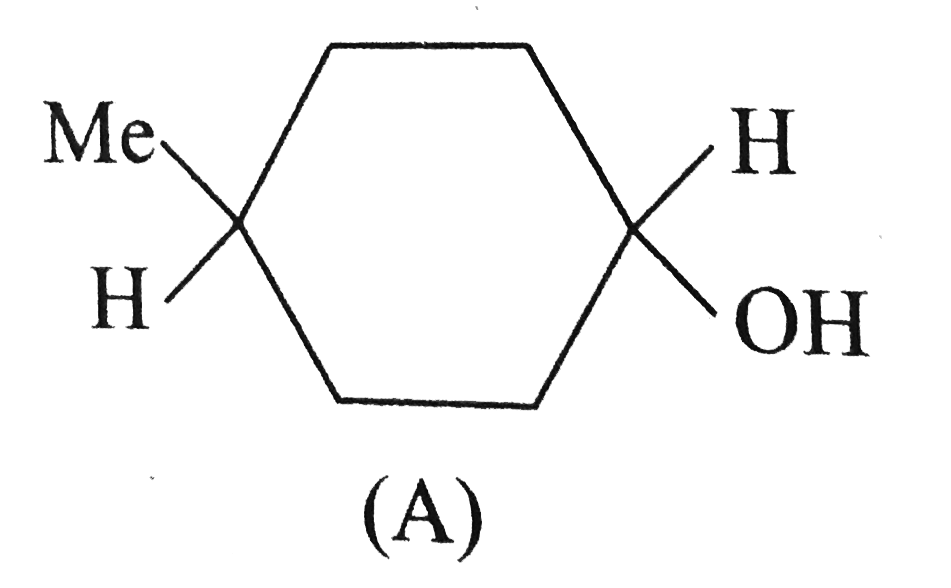Dehydration of cyclopentyl carbinol with conc.H2SO4 forms
Cyclopentene
Cyclohexene
Cyclohexane
none of these
The correct Answer is:D
To solve the problem of what product is formed when cyclopentyl carbinol undergoes dehydration with concentrated sulfuric acid, we can follow these steps:
Step 1: Identify the Reactant
The reactant is cyclopentyl carbinol, which can be represented as:
C5H10O
This structure consists of a cyclopentane ring with a hydroxyl (OH) group attached to a carbon atom.
Step 2: Protonation of the Alcohol
When cyclopentyl carbinol is treated with concentrated sulfuric acid (H₂SO₄), the first step is the protonation of the hydroxyl group. The sulfuric acid donates a proton (H⁺) to the oxygen of the hydroxyl group, making it a better leaving group:
C5H10OH+H+→C5H10OH+2
Step 3: Formation of Carbocation
After protonation, water (H₂O) can leave, leading to the formation of a carbocation:
C5H10OH+2→C5H+10+H2O
This results in a cyclopentyl carbocation.
Step 4: Ring Expansion
Cyclopentyl carbocation is less stable due to ring strain. According to Baeyer strain theory, five-membered rings are less stable than six-membered rings. Therefore, the carbocation can undergo ring expansion to form a more stable six-membered ring (cyclohexane):
C5H+10→C6H+12
This results in the formation of a cyclohexyl carbocation.
Step 5: Deprotonation
The final step involves the loss of a proton from the cyclohexyl carbocation, leading to the formation of cyclohexene:
C6H+12→C6H10+H+
Final Product
The final product of the dehydration of cyclopentyl carbinol with concentrated sulfuric acid is cyclohexene.
Summary
Thus, the product formed is:
Cyclohexene
---
The reactant is cyclopentyl carbinol, which can be represented as:
C5H10O
This structure consists of a cyclopentane ring with a hydroxyl (OH) group attached to a carbon atom.
When cyclopentyl carbinol is treated with concentrated sulfuric acid (H₂SO₄), the first step is the protonation of the hydroxyl group. The sulfuric acid donates a proton (H⁺) to the oxygen of the hydroxyl group, making it a better leaving group:
C5H10OH+H+→C5H10OH+2
After protonation, water (H₂O) can leave, leading to the formation of a carbocation:
C5H10OH+2→C5H+10+H2O
This results in a cyclopentyl carbocation.
Cyclopentyl carbocation is less stable due to ring strain. According to Baeyer strain theory, five-membered rings are less stable than six-membered rings. Therefore, the carbocation can undergo ring expansion to form a more stable six-membered ring (cyclohexane):
C5H+10→C6H+12
This results in the formation of a cyclohexyl carbocation.
The final step involves the loss of a proton from the cyclohexyl carbocation, leading to the formation of cyclohexene:
C6H+12→C6H10+H+
The final product of the dehydration of cyclopentyl carbinol with concentrated sulfuric acid is cyclohexene.
Thus, the product formed is:
Cyclohexene
Similar Questions
Knowledge Check
Acetone on heating with conc. H2SO4 mainly gives
AmesityleneBmesityl oxideCtolueneDxylene.Acetone on heating with conc. H2SO4 mainly gives
AmesityleneBmesityl oxideCtolueneDxylene.Acetone on heating with conc. H2SO4 mainly gives
AmesityleneBmesityl oxideCtolueneDxylene.
During the dehydration of alcohols to alkenes by heating with conc. H2SO4, the initiating step is :
View Solution on dehydration with conc. H2SO4 forms predominantly :
on dehydration with conc. H2SO4 forms predominantly :
View SolutionThe dehydration of alcohols in the presence of conc. H2SO4 at 170∘C involves one of the following :
View SolutionKl when heated with conc .H2SO4 , it forms
View Solution
Dehydration of (A) with conc. H2SO4 gives a compound that exists in two isomeric forms. Give the structurest of both the isomers.
View Solution
